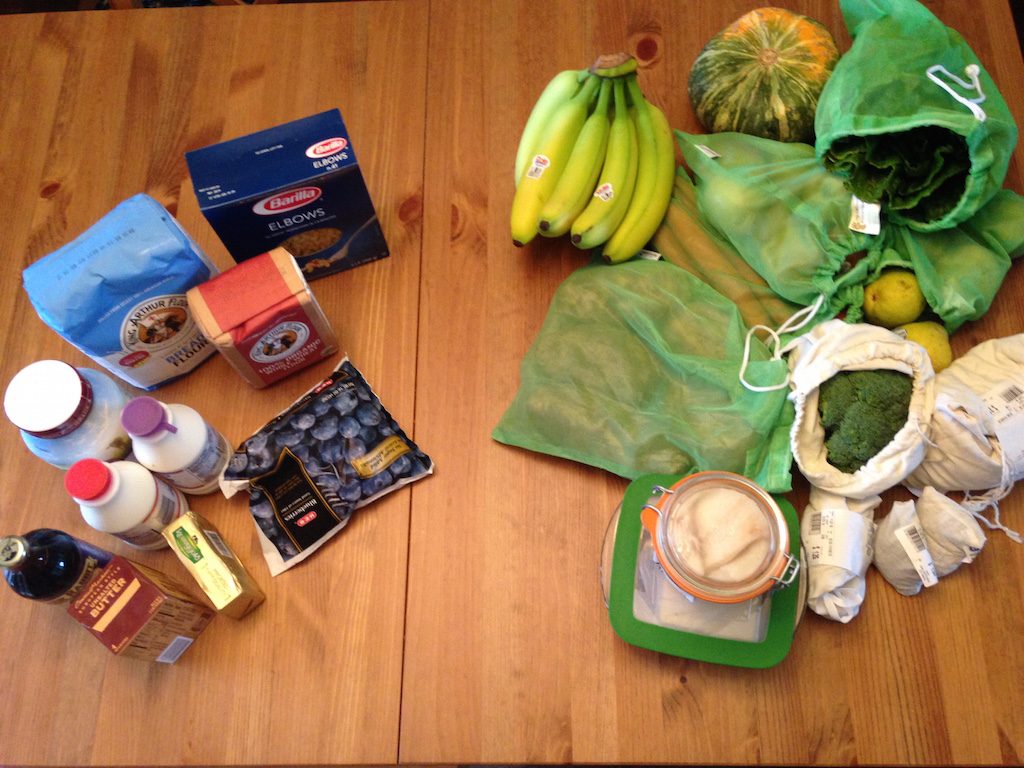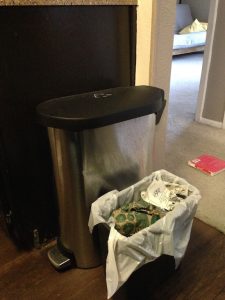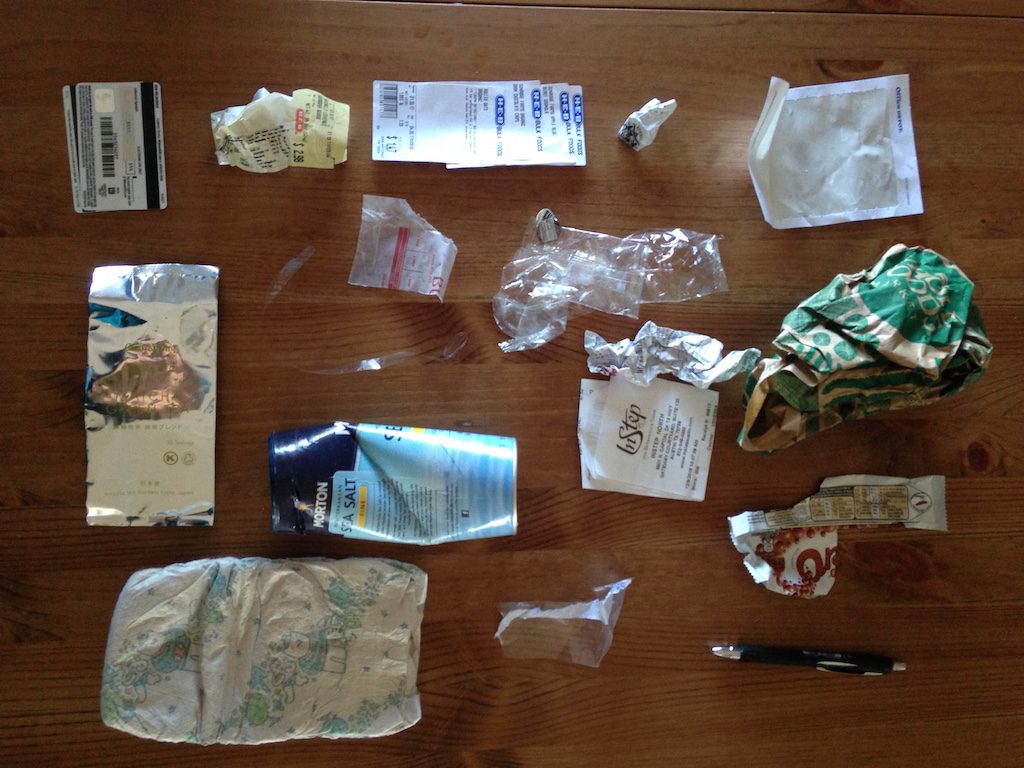It’s now been a year since I started my zero waste project last February. When I mentioned this to Mike, he couldn’t believe it had been that long; I’m taking that as a good sign that it hasn’t been too catastrophic for our household! Since it has now been a full year that I’ve been trying to reduce our household waste, I thought it was time to share how we’re doing and my reflections on this process.
How much have we reduced?
I estimate that we have reduced our landfill trash output by about 80%. I say this because we used to empty our regular-sized kitchen bin once a week, but once zero waste was in full swing, it once took five weeks for it to fill up. We’ve since switched to a smaller trash can, and now use the bigger one for recycling instead. I think the smaller one fills up about every 3 weeks. We do have a small trash can in our bathroom (emptied maybe once a month? Seldom full) and one for disposable diapers in the other bathroom, which contains 7 diapers per week. (Using cloth overnight hasn’t worked for us.)
What have I changed?
Let’s just do a quick rundown. My goal throughout this year was to focus particularly on what we regularly ‘consumed’ in our household, and get it either without packaging (first choice) or in a more minimal, more recyclable packaging option (second choice). Or – eliminate the item altogether. Here’s what I did:
- Started composting food scraps
- Started buying as much food unpackaged as I could: produce, most meat, most cheese, most dry goods – I bring my own glass containers or cloth/mesh bags for these
- Chose more recyclable packaging options for certain items: yogurt (glass jar), pasta (cardboard box)
- Chose larger packages for a few things: frozen peas (larger bag equals less bag overall for the quantity)
- Eliminated the regular purchase ‘problematically’ packaged things like chips (buy them only as occasional treats)
- Cut down our disposable diaper use and quit using disposable wipes
- Improved my recycling efforts for a few things I didn’t know I could recycle before, such as tin foil and plastic bags
- Got rid of most disposable items, or else hid them away for real emergencies: straws (we use stainless steel ones), napkins, paper towels, tissues; the only disposable thing I buy very frequently is toilet paper
Through this process, I also streamlined how I cook, quit buying certain things altogether, and occasionally just realised I could use less of something (e.g. toothpaste).

As to achievement, it’s actually beyond what I thought would be possible at the beginning. I do also feel that we’ve hit a comfortable ‘coasting’ speed: most of my new habits now feel normal, and I think reducing our trash further would require some kind of ‘whole new level’ of effort and creativity.
What’s in our trash?
Here’s a sampling of the kinds of things we still throw away. There are labels from the deli and bulk bins, produce stickers, little bits of plastic, a chicken wrapper because I don’t have a container large enough to hold a whole chicken, old credit cards, a used-up pen, and a disposable diaper. (But I got a clean one to take the photo!)
What I’ve learned
This process has been mind-blowing and revealing. Trying to eliminate trash from my life has required me to examine every part of my shopping habits and every thing we use and eat regularly, and to think about the value and purpose of each thing. It’s very similar, in fact, to the KonMari method: taking each item, one by one, and thinking honestly about why it’s part of my life. I’ve also done a lot of reading and research to gain skills, find alternatives, and learn about how daily activities affect the environment.
So let’s talk about what I’ve learned.
I’ve discovered something about trash. It’s everywhere, but most of it is nearly invisible to us because we’re used to seeing it, and we dismiss it as inevitable because it comes with necessary things like food. I never really noticed the packaging of my meat, the stickers on my vegetables, and the myriad of little tags, safety seals, air pillows, tissue paper, boxes, ties, rubber bands, and other detritus that I regularly gathered and threw away. I never realised how many little minutes of time I spent gathering that stuff for the trash, or being annoyed at how the trash stank or overflowed. Once the trash was drastically reduced, however, I realised how much time and mental space its absence liberated; I don’t think I would ever have been able to understand this had I not experienced it.
As far as knowledge, I’ve done tons of reading about garbage, manufacture, environmental issues, and consumption. I’ve done this to satisfy my own curiosity, and as a kind of professional development for my role as a homemaker, because buying and using everyday stuff is a large part of my role, and I do it on behalf of a whole family now, not just myself. I’ll list some of my favourite books below in case you’d like to read them too, but the big thing I have learned is that what we do in our everyday lives is connected to the environment, and the environment is always connected, globally, with us. Of course the system is vast and complex, but the water we drink and food we eat are affected by the stuff we use and what we throw away. As you saw above, I still throw things in the trash because I can’t avoid all waste, but I have come to feel strongly that I do not wish to participate in the more blatantly throwaway parts of our culture.
And, as it turns out, there are a lot of alternative ways to do things. This is what I have also learned: not all trash is an inevitability. We can choose to avoid much of it. In an ideal world, we could avoid it all; but in this current world, there is still plenty that can be eliminated. In retrospect, I suppose I began this project partly to test that very idea. I had many hesitancies and concerns: I have a baby and I’m tired. We are on a budget. I want to live a normal life in society, not be a reclusive hippy. I want to have time for the things I enjoy. We don’t live in San Francisco. (Seriously, the number of zero waste folks who live there!) But I feel I have seen for myself that major changes were possible for us, even in many cases enjoyable and beneficial.
Which brings me back to where I began, last year. What even made me decide to try going zero waste? Perhaps I was a little crazy, because severely sleep-deprived. But thinking back now, I realise that it was because the idea of a zero waste home inspired me creatively. Although I was somewhat interested in environmental issues, I don’t think I was well educated or even overwhelmingly passionate about it back then. Rather, the idea of an (aspiring) zero waste home appealed to me because I was a new mother and now a full time homemaker, seeking to discover what kind of homemaker I was. A zero waste home was an imaginative vision in which I no longer had to accept my 21st-century culture’s assumptions about how things were. In this home, things did not enter to be wasted and discarded or to serve my own convenience, but to nourish us or to serve a useful, ongoing purpose. And in this vision, homemaking was less about consumption (being preyed upon by advertising and cultural pressure) and more about imagination, craft, production, inventiveness, and being satisfied.
Going forward, I am very pleased with how things currently stand in my routines and with how much waste we have eliminated. Out of curiosity, I’m weighing our trash as I take it out, so I’ll share those numbers once I have a longer-term average over some weeks. I’m also realistic about how new stages of life might affect what I can do on the zero waste front: if I had another baby, for example, I’m sure I would have to modify some of my current habits, and so I make no sweeping vows. But for now, I feel happy.
I also really enjoy not smelling stinky trash as I walk by the kitchen.
Some books on waste, the environment and consumerism that I recommend
Edward Humes, Garbology
Gripping and very readable, a look at landfill in America and the cultural issues of trash and waste
Bea Johnson, Zero Waste Home
The basic manual for reducing waste in the home
Beth Terry, Plastic Free
About plastics and their environmental and health effects, and practical advice for alternatives in everyday life
Elizabeth L. Cline, Overdressed: The Shockingly High Cost of Cheap Fashion
About the fast fashion industry and its environmental effects, as well as ethical issues surrounding labor
Paco Underhill, Why We Buy
A fun look at how retailers get people to shop, useful to make you look differently at why we buy things
William McDonough and Michael Braungart, Cradle to Cradle
A theoretical book about how products can be designed to eliminate waste


We’ve done the same in our household. Recyclable packaging has been our focus. Our recycle bin fills up three times faster than trash. We have reduced by 50%. The only other area left is materials from trainings and meat packaging. Be encouraged. Faithful in the small things.
Wow, that’s great! A 50% reduction is really impressive! We have the same thing with recycling – it fills up far more frequently than trash.